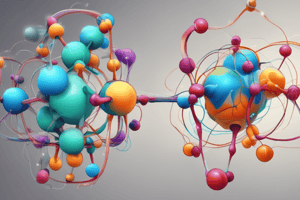Podcast
Questions and Answers
What is the primary characteristic of ionic bonds?
What is the primary characteristic of ionic bonds?
- They occur only between nonmetals.
- They are formed through the transfer of electrons. (correct)
- They result in nonpolar compounds.
- They involve the sharing of electron pairs.
Which type of bond is primarily responsible for the malleability and electrical conductivity of metals?
Which type of bond is primarily responsible for the malleability and electrical conductivity of metals?
- Covalent bonds
- Hydrogen bonds
- Metallic bonds (correct)
- Ionic bonds
How does bond energy relate to bond strength?
How does bond energy relate to bond strength?
- Higher bond energy indicates a stronger bond. (correct)
- Higher bond energy indicates a weaker bond.
- Lower bond energy indicates a stronger bond.
- Bond energy is unrelated to bond strength.
Which factor determines the molecular geometry of a compound?
Which factor determines the molecular geometry of a compound?
What characterizes a polar covalent bond?
What characterizes a polar covalent bond?
What is the primary limitation of the octet rule?
What is the primary limitation of the octet rule?
Which intermolecular force is the weakest?
Which intermolecular force is the weakest?
Which bond type primarily occurs between metals and nonmetals?
Which bond type primarily occurs between metals and nonmetals?
Flashcards are hidden until you start studying
Study Notes
Chemical Bonding
-
Definition: Chemical bonding refers to the lasting attractions between atoms that enable the formation of chemical compounds.
-
Types of Chemical Bonds:
-
Ionic Bonds:
- Formed through the transfer of electrons from one atom to another.
- Results in the creation of positively charged ions (cations) and negatively charged ions (anions).
- Common in compounds formed between metals and nonmetals (e.g., NaCl).
-
Covalent Bonds:
- Involves the sharing of electron pairs between atoms.
- Can be single (one pair of electrons), double (two pairs), or triple (three pairs).
- Common in compounds formed between nonmetals (e.g., H2O).
-
Metallic Bonds:
- Occur between metal atoms, characterized by a "sea of electrons" that are free to move.
- Gives rise to properties such as electrical conductivity and malleability.
-
-
Bond Characteristics:
- Bond Length: The distance between the nuclei of two bonded atoms; influences bond strength.
- Bond Energy: The energy required to break a bond; higher bond energy indicates a stronger bond.
- Polarity: The distribution of electrical charge across a molecule; involves the electronegativity of atoms.
- Nonpolar covalent: equal sharing of electrons.
- Polar covalent: unequal sharing of electrons leading to partial charges.
-
Intermolecular Forces (not to be confused with bonding):
- Hydrogen Bonding: Special type of dipole-dipole interaction due to a hydrogen atom bonded to a highly electronegative atom (F, O, N).
- Dipole-Dipole Interactions: Occur between polar molecules, affecting boiling and melting points.
- London Dispersion Forces: Weakest intermolecular force occurring due to temporary dipoles in molecules.
-
Molecular Geometry:
- Determined by the number of bonds and lone pairs around a central atom.
- Key shapes include linear, trigonal planar, tetrahedral, trigonal bipyramidal, and octahedral.
-
Applications of Chemical Bonding:
- Understanding properties of materials (e.g., melting/boiling points).
- Predicting reactivity and stability of compounds.
- Basis for biological molecules (DNA, proteins).
-
Valence Shell Electron Pair Repulsion (VSEPR) Theory:
- Used to predict the geometry of molecules based on the idea that electron pairs repel each other.
-
Octet Rule:
- Atoms tend to bond in such a way that they have eight electrons in their valence shell, achieving stability similar to noble gases.
Use this guide to grasp foundational concepts surrounding chemical bonding, helping to reinforce understanding in both theoretical and practical applications.
Chemical Bonding
- Definition: Attractive forces between atoms allowing the formation of chemical compounds.
- Types of Chemical Bonds:
- Ionic Bonds: Electron transfer between atoms, creating positively charged ions (cations) and negatively charged ions (anions). Common in metals and nonmetals (e.g., NaCl).
- Covalent Bonds: Sharing of electron pairs between atoms. Can be single, double, or triple, depending on the number of electron pairs shared. Common in nonmetal compounds (e.g., H2O).
- Metallic Bonds: Occur between metal atoms. Characterized by a "sea of electrons" allowing for high electrical conductivity and malleability.
Bond Characteristics
- Bond Length: The distance between the nuclei of two bonded atoms. Shorter bond lengths typically indicate stronger bonds.
- Bond Energy: The energy required to break a bond. High bond energy implies a strong bond.
- Polarity: Describes the distribution of electrical charge in a molecule, influenced by the electronegativity of atoms.
- Nonpolar Covalent: Equal sharing of electrons.
- Polar Covalent: Unequal sharing of electrons leading to partial charges.
Intermolecular Forces
- Hydrogen Bonding: A strong dipole-dipole interaction involving a hydrogen atom bonded to a highly electronegative atom (e.g., F, O, N).
- Dipole-Dipole Interactions: Occur between polar molecules, affecting boiling and melting points.
- London Dispersion Forces: The weakest intermolecular force occurring due to temporary dipoles in molecules.
Molecular Geometry
- Determined by the number of bonds and lone pairs around a central atom.
- Key shapes include:
- Linear
- Trigonal Planar
- Tetrahedral
- Trigonal Bipyramidal
- Octahedral
Applications of Chemical Bonding
- Understanding material properties like melting and boiling points.
- Predicting reactivity and stability of compounds.
- Foundation for biological molecules (e.g., DNA, proteins).
Valence Shell Electron Pair Repulsion (VSEPR) Theory
- Predicts molecular geometry based on the repulsion between electron pairs.
Octet Rule
- Atoms tend to bond to achieve eight electrons in their valence shell, resembling the stable configuration of noble gases.
Studying That Suits You
Use AI to generate personalized quizzes and flashcards to suit your learning preferences.




